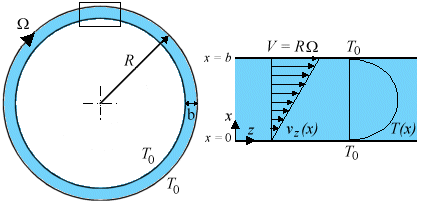Heat Transfer Problem :
Maximum temperature in lubricant by viscous heating
Problem.
An oil (of viscosity ![]() and thermal conductivity k) acts as a lubricant between two coaxial cylinders. The inner cylinder is stationary and the outer cylinder of radius R rotates at an angular velocity
and thermal conductivity k) acts as a lubricant between two coaxial cylinders. The inner cylinder is stationary and the outer cylinder of radius R rotates at an angular velocity ![]() . The clearance between the cylinders is b, which is small compared to the radii of the cylinders; so, curvature effects can be neglected and the cylindrical system can be approximated by a plane narrow slit (to be solved in Cartesian coordinates) as shown in the figure. Derive an expression for the maximum temperature in the lubricant if both cylinders are at temperature T0. Neglect the temperature dependence of
. The clearance between the cylinders is b, which is small compared to the radii of the cylinders; so, curvature effects can be neglected and the cylindrical system can be approximated by a plane narrow slit (to be solved in Cartesian coordinates) as shown in the figure. Derive an expression for the maximum temperature in the lubricant if both cylinders are at temperature T0. Neglect the temperature dependence of ![]() and k, but explicitly take into account the heat generated by viscous dissipation.
and k, but explicitly take into account the heat generated by viscous dissipation.

Figure. Temperature profile for viscous heat generation. The rectangular section in the flow between two coaxial cylinders can be approximated by the plane narrow slit on neglecting the curvature of the bounding surfaces.
Solution.
The clearance between the cylinders is b, which is small compared to the radii of the cylinders; so, curvature effects are neglected and the cylindrical system is approximated by a plane narrow slit. From a shell momentum balance in Cartesian coordinates over a thin rectangular slab of thickness ![]() x, the momentum flux (shear stress) distribution is obtained as
x, the momentum flux (shear stress) distribution is obtained as
| (1) |
On substituting Newton's law of viscosity (![]() ), the expression for the velocity profile is
), the expression for the velocity profile is
| (2) |
The integration constants K1 and K2 are determined using the boundary conditions:
| (3) |
| (4) |
On substituting the integration constants, the velocity profile is given by
| (5) |